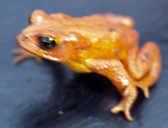|
Incilius periglenes (Savage, 1967)
Sapo Dorado, Golden Toad | family: Bufonidae genus: Incilius |
 © 2009 Richard D. Sage (1 of 2) |
|
|
|
Description Distribution and Habitat Country distribution from AmphibiaWeb's database: Costa Rica
Life History, Abundance, Activity, and Special Behaviors Jacobson and Vandenberg (1991) describe two call types, one as a release call (usually in combination with body vibrations) and characterized as a low intensity trill, and another which was not linked to any physical interactions (only one male issued the call while in amplexus). Records and personal observations of B. periglenes document its abundance from 1971 to 1987, after which it abruptly disappeared (with 1,500 individuals recorded in 1987, five individuals found in 1988 and one in 1989; Pounds and Crump 1994), and it has not been seen since (Pounds et al. 1997). Trends and Threats The rapid manner in which this population vanished, from 1500 to none in just a few years, has led to the argument that B. periglenes suffered from a high adult mortality rather than the gradual effects expected from poor juvenile recruitment or unsuccessful breeding (Pounds and Crump 1994). This reasoning, in conjunction with the toad's pristine habitat, have centered causal hypotheses around abiotic factors involving climate change (Pounds et al. 1999). Field studies reported complete egg desiccation in both 1982 (Jacobson and Vandenberg 1991) and in 1987 (Crump et al. 1992). This seems readily explainable by the warming of the pools and the low level of precipitation, which produced drier conditions overall (Pounds and Crump 1994). However, a causal explanation for the disappearance of the adult toads is not as forthright. Certain factors have been ruled out, such as the detrimental effects of Ultraviolet (UV) exposure and pH contamination. Crump et al. (1992) argue that the Golden Toad's fossorial lifestyle and the heavy cloud cover of the montane environment should prevent damaging UV radiation, while their tests of pH change in cloud water, convective and advective precipitation turned up negative. Examining weather data, Pounds and Crump (1994) noted the correlation between the desiccation events and the adult disappearance, and the 1982-1983 and the 1986-1987 El Niño/Southern Oscillation. This led them to propose several climate-based hypotheses: moisture stress, temperature stress, climate-linked epidemic hypothesis (see Pounds et al. 2006), and the climate-linked contaminant pulse hypothesis. Pounds et al. (1999) added support to the climate-induced decline in their careful analysis of precipitation, air temperature, sea surface temperature, and stream flow patterns in relation to tropical anuran, avian, and anoline lizard communities. They concluded, as did Pounds et al. (2006) that it was not simply the effect of the El Niño/Southern Oscillation, but rather a global warming trend in general (this trend remained significant with the El Niño fluctuations included) which crossed a threshold in late 1980's and precipitated a broad tropical anuran decline. This was matched by a decline in anoline lizards, and resulted in significant restructuring of tropical avian communities. However, Lips et al. (2008) reanalyzed the data of Pounds et al. (2006), and argued that the climate-linked epidemic hypothesis was not supported, as did Rohr et al. (2008). Anchukaitis and Evans (2010) reconstructed a century of climatic data for Monteverde, Costa Rica, and suggested that cloud forest ecology changes have been driven by natural variability in the local climate (in particular, extreme dry periods associated with El Niño weather patterns) rather than by anthropogenic climate forcing. Possible reasons for amphibian decline Prolonged drought Comments A Spanish-language species account can be found at the website of Instituto Nacional de Biodiversidad (INBio).
References
Anchukaitis, K. J., and Evans, M. N. (2010). ''Tropical cloud forest climate variability and the demise of the Monteverde golden toad .'' Proceedings of the National Academy of Sciences, online before print, http://www.pnas.org/content/early/2010/02/25/0908572107.abstract. . Crump, M. L., Hensley, F. R., and Clark, K. L. (1992). ''Apparent decline of the Golden Toad: Underground or extinct?'' Copeia, 1992(2), 413-420. Holdridge, L. R. (1967). Life Zone Ecology. Tropical Science Center, San Jose, Costa Rica. Jacobson, S. K. and Vandenberg, J. J. (1991). ''Reproductive ecology of the endangered Golden Toad (Bufo periglenes).'' Journal of Herpetology, 25(3), 321-327. Lips, K. L., Diffendorfer, J., Mendelson, J. R., III, and Sears, M. W. (2008). ''Riding the wave: Reconciling the roles of disease and climate change in amphibian declines.'' PLoS Biology, 6, e72. Pounds, J. A., Fogden, M. P. L., Savage, J. M., and Gorman, G. C. (1997). "Tests of null models for amphibian declines on a tropical mountain." Conservation Biology, 11(6), 1307-1322. Pounds, J. A., Fogden, M. P. L., and Campbell, J. H. (1999). ''Biological response to climate change on a tropical mountain.'' Nature, 398(6728), 611-615. Pounds, J. A., and Crump, M. L. (1994). ''Amphibian declines and climate disturbance: The case of the Golden Toad and the Harlequin Frog.'' Conservation Biology, 8(1), 72-85. Rohr, J. R., Raffel, T. R., Romansic, J. M., McCallum, H., Hudson, P. J. (2008). ''Evaluating the links between climate, disease spread, and amphibian declines.'' Proceedings of the National Academy of Sciences, 105, 17436–17441. Savage, J. M. (1966). ''An extraordinary new toad (Bufo) from Costa Rica.'' Revista de Biologica Tropical, 14(2), 153-167. Originally submitted by: Sean Schoville (first posted 1999-10-01) Edited by: Vance T. Vredenburg (2010-03-15) Species Account Citation: AmphibiaWeb 2010 Incilius periglenes: Sapo Dorado <https://amphibiaweb.org/species/253> University of California, Berkeley, CA, USA. Accessed Mar 28, 2025.
Feedback or comments about this page.
Citation: AmphibiaWeb. 2025. <https://amphibiaweb.org> University of California, Berkeley, CA, USA. Accessed 28 Mar 2025. AmphibiaWeb's policy on data use. |




 Map of Life
Map of Life